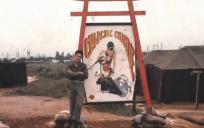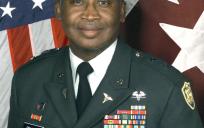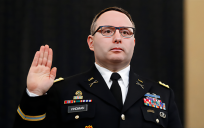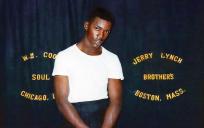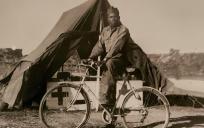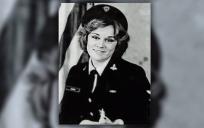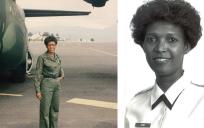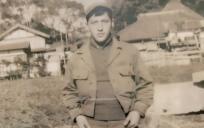Record date:
John E. Sandri Transcript .pdf
John E. "Sandy" Sandri, SP5 US Army DASPO
John E. Sandri, like many during the Vietnam War, knew the draft was going to affect him. Opting to enlist instead, Sandri received orders for DASPO [Department of the Army Special Photographic Office] Pacific, just one step from Vietnam. He went in “ready for something,” geared up from basic and advanced training. Sandri watched the face of the war change. He would ride out the Tet Offensive bunkered in a Đà Nẵng airport and subsisting on rations. His unit back at the villa in Saigon would engage in fire in the city streets. When Sandri returned, beautiful Saigon, with its brick and cobblestone streets and French architecture, was full of sandbags and wired fences.
Before enlisting in the US Military, John E. Sandri worked for a local TV station as a cameraman, also sharing an interest in radio and photography, taking some courses in high school. With draft numbers rising for the Army, Sandri eventually enlisted in 1967 and after minor tests and assessments received an 84C MOS [Military Occupational Specialty] to serve as a motion picture cameraman. Officers would attempt to encourage Sandri to change to artillery or infantry, but he stuck with his MOS and completed basic training at Fort Benning, Georgia, learning motion picture the Army way. It was an anxious day when it came time to receive orders. While some men went right to Vietnam, some to Germany, and some to DASPO Panama, Sandri’s orders were for DASPO Pacific in Fort Shafter, Hawaii.
Sandri arrived late night at Fort Shafter where he would have to remain outside the barracks until the morning before being checked in. There would be some minor evaluation on his filming capabilities, and he underwent exercises to get familiar with the equipment, training on ARRIFLEXs and 16mm cameras. Sandri’s first assignment would indeed send him to Vietnam. Arriving at Tan Son Nhut Airport in Saigon reminded Sandri of a 1930s film. His first impressions were full of new sights and different sounds, and the smell of cheap fuel and blue smoke rising throughout the city. Gated with a front yard, a three-story French villa served as living quarters for Sandri and the rest of his unit. Light-hearted pranks and opportunities to try local foods offered relief for Sandri and company who were all in the combat zone.
On Sandri’s filming of a combat sweep in An Lộc, the unit he was shooting would come under fire from enemy Viet Cong. With bullets flying overhead, he managed to change his empty roll of film over and continue his work. For Sandri’s second duty to Vietnam, the danger did not let up. Stopping in Đà Nẵng on a flight over to Qui Nhơn put Sandri and a fellow soldier into the reaches of the Tet Offensive. Cut-off from communications with his unit in Saigon, he was bunkered along with other troops in a Đà Nẵng airport. They survived nearby shelling and subsisted off rations for six days before completing their mission and returning to a very different Saigon. Barbed-wire fences and sandbags, along with a stricter curfew erased the notion that the war was only being fought in the bush.
In Korea and Thailand, Sandri would serve two separate temporary duty assignments while with DASPO. Difficulties in Korea included lugging severely heavy equipment and lack of sufficient food. Thailand provided Sandri a window into the humanitarian efforts of the US Army, as they sponsored orphanages and reading programs. His own work involved capturing the day-to-day life of troops on military installations.
Thailand was the last assignment before Sandri’s departure from DASPO and the Army in 1969. Anti-war sentiments were at an all-time high stateside, but Sandri never felt there was pressure on him for having served in the Vietnam War upon his return. Reflecting, he sees the many intricate socio-political events that framed the war and continued to shape it while he served and until the war’s end in 1975. Sandri is proud to have served with DASPO and wishes that its legacy serves to educate. He hopes that the lives and efforts of those behind the cameras is also recognized as his efforts and theirs helped to preserve the history of war. He is grateful for the training and experience and the opportunity to be a part of the uniqueness that DASPO was in the US Army.
